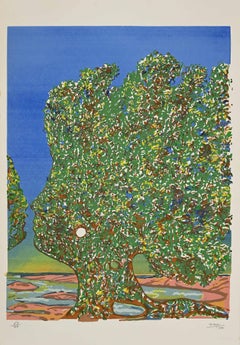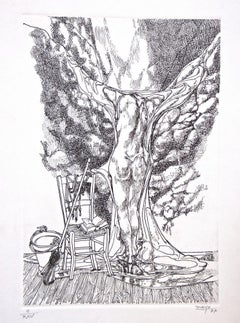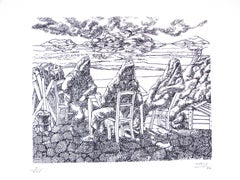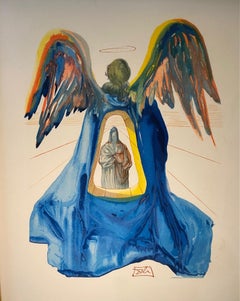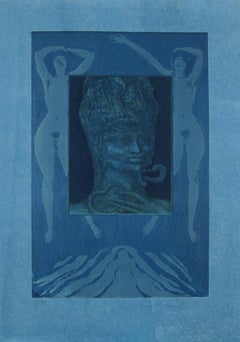Mayo (Antoine Malliarakis) Art
to
1
5
4
1
4
1
Overall Height
to
Overall Width
to
5
5
3
1
5
6,886
3,210
2,514
1,217
4
1
Artist: Mayo (Antoine Malliarakis)
L'Arbre de l'Amour (The Tree of Love) - Original Lithograph by Mayo - 1980
By Mayo (Antoine Malliarakis)
Located in Roma, IT
Beautiful hand signed lithograph by the Greek painter naturalized French citizen Antoine Malliarakis (Mayo, 1905-1990).
Edition 68/100, signed and dated in pencil lower right. Very ...
Category
1980s Surrealist Mayo (Antoine Malliarakis) Art
Materials
Lithograph
The Painter - b/w Etching - 1977
By Mayo (Antoine Malliarakis)
Located in Roma, IT
Image dimensions: 33x22.5 cm.
Edition of 25 prints, numbered and hand signed.
Very good conditions.
Category
1970s Surrealist Mayo (Antoine Malliarakis) Art
Materials
Etching
Personnage sans Tête - B/w Etching - Mid 1900
By Mayo (Antoine Malliarakis)
Located in Roma, IT
Personnage sans Tête is an original black and white etching on paper, realized by the artist Antoine Mayo, art name of Malliarakis (1905-1990)
Signed in pencil on lower right margin...
Category
Mid-20th Century Surrealist Mayo (Antoine Malliarakis) Art
Materials
Etching
Surrealist Nude - Original b/w Etching - 1977
By Mayo (Antoine Malliarakis)
Located in Roma, IT
Image dimensions: 33x22.5 cm.
Edition of 25 prints, numbered and hand signed.
Excellent conditions.
Category
1970s Surrealist Mayo (Antoine Malliarakis) Art
Materials
Etching
The Hooded - Original b/w Etching - 1977
By Mayo (Antoine Malliarakis)
Located in Roma, IT
Image dimensions: 23x28 cm.
Edition of 25 prints, numbered and hand signed.
Excellent conditions.
Category
1970s Surrealist Mayo (Antoine Malliarakis) Art
Materials
Etching
Related Items
La divine comédie Purgatoire 33 Dante purifié by Salvador Dali - Print multiple
By Salvador Dalí
Located in Geneva, CH
Color engraving on wood from the Dali's portfolio " The Divin Comedy"
Lithograph without numbering
Framed. Total size with frame 30x38 cm
In perfect condition
Category
1960s Surrealist Mayo (Antoine Malliarakis) Art
Materials
Engraving, Lithograph
H 12.6 in W 9.85 in D 0.4 in
Ernst Fuchs Sphinx in Pharao Surreal Color Etching Vienna Fantastic Realism 1967
By Ernst Fuchs
Located in Meinisberg, CH
Ernst Fuchs
(Austrian, 1930 - 2015)
Sphinx in Pharao
Sheet Nr. 6 from the Folio “Die Sieben Bilder und Sprüche der Sphinx”, published in Autumn of 1967 by Galerie Sydow in Frankfurt, Germany.
• Aquatint Etching
• Ed. 79/99
• Sheet ca. 59 x 41.5 cm
• Plate signed
• Signed & numbered by the artist in pencil
Worldwide shipping is complimentary - There are no additional charges for handling & delivery.
Ernst Fuchs was an Austrian painter, draftsman, printmaker, sculptor, architect, stage designer, composer, poet, and one of the founders of the Vienna School of Fantastic Realism.
I discovered him through H.R. Giger ‘s work, who himself was greatly inspired by the creations of Fuchs and on several occasions exhibited his friend ‘s art in his museum, the Château St-Germain, Gruyères, Switzerland.
I actually own the original folio box...
Category
1960s Surrealist Mayo (Antoine Malliarakis) Art
Materials
Paper, Ink, Aquatint, Etching
Free Shipping
H 23.23 in W 16.34 in D 0.04 in
"Bonjour" by Max Ernst, Good Day, Surrealism, Light Colors, Figurative
By Max Ernst
Located in Köln, DE
Etching in colours by Max Ernst.
"Bonjour", 1966
66,5 x 50,1 cm
Copy 7/99
Edition of 111 copies (approx.)
Category
1960s Surrealist Mayo (Antoine Malliarakis) Art
Materials
Etching, Aquatint
L'enlèvement d'Europe by Hans Erni - Print 43x60 cm
By Hans Erni
Located in Geneva, CH
Hans ERNI is an artist born in Switzerland in 1909 and died in 2015. His works have been sold at public auction 3,987 times, mostly in the Print-Multiple category. The oldest auction...
Category
1980s Surrealist Mayo (Antoine Malliarakis) Art
Materials
Lithograph
La divine comédie (1950-1980) by Salvador Dali - Print multiple 25x32 cm
By Salvador Dalí
Located in Geneva, CH
Color engraving on wood from the Dali's portfolio " The Divin Comedy"
Lithograph without numbering
Framed. Total size with frame 30x38 cm
In perfect condition
Category
1960s Surrealist Mayo (Antoine Malliarakis) Art
Materials
Engraving, Lithograph
H 12.6 in W 9.85 in D 0.4 in
Dog print by California Funk "nut art" painter world renowned for dog portraits
By Roy De Forest
Located in New York, NY
Roy De Forest
Untitled (Dog), 1981
Color lithograph with deckled edges. Floated and framed.
Pencil signed and numbered from the edition of 125
Frame Included: held in original vintage white frame
Wonderful whimsical rare 1981 lithograph by the incredibly popular and beloved Roy de Forest, famous for his paintings and prints of dogs...
Category
1980s Surrealist Mayo (Antoine Malliarakis) Art
Materials
Lithograph
H 35.25 in W 26.75 in D 1 in
Marc Chagall - Green River - Original Lithograph
By Marc Chagall
Located in Collonge Bellerive, Geneve, CH
Marc Chagall
Original Lithograph
Double-page spread from the 1974 book "Chagall" by André Pieyre de Mandiargues.
Unsigned, edition of approximately 10,000
Published by Maeght
1974
D...
Category
1960s Surrealist Mayo (Antoine Malliarakis) Art
Materials
Lithograph
Extremely rare 2-sided lithographic announcement to Galerie Maeght vernissage
By Joan Miró
Located in New York, NY
Joan Miró
Extremely rare 2-sided lithographic announcement to Galerie Maeght vernissage, 1953
2 sided Lithographic invitation (header image shows both front and back on one panel)
Un...
Category
1950s Surrealist Mayo (Antoine Malliarakis) Art
Materials
Lithograph
Imaginations and Objects of The Future Melting Space Time
By Salvador Dalí
Located in Hollywood, FL
ARTIST: Salvador Dali
TITLE: Imaginations & Objects of The Future Melting Space Time
MEDIUM: Etching
SIGNED: Hand Signed
PUBLISHER: Merrill Chase, Chicago/Alan Rich, New York
E...
Category
1970s Surrealist Mayo (Antoine Malliarakis) Art
Materials
Etching
Manhattan Skyline
By Salvador Dalí
Located in Hollywood, FL
ARTIST: Salvador Dali
TITLE: Manhattan Skyline
MEDIUM: Lithograph
SIGNED: Hand Signed
PUBLISHER: Levine & Levine
EDITION NUMBER: 49/150
MEASUREMENTS: 29.75" x21.25"
YEAR: 19...
Category
1970s Surrealist Mayo (Antoine Malliarakis) Art
Materials
Lithograph
Marc Chagall - Original Lithograph
By Marc Chagall
Located in Collonge Bellerive, Geneve, CH
Marc Chagall
Original Lithograph
1963
Dimensions: 32 x 24 cm
Reference: Chagall Lithographe 1957-1962. VOLUME II.
Condition : Excellent
Marc Chagall (born in 1887)
Marc Chagall was born in Belarus in 1887 and developed an early interest in art. After studying painting, in 1907 he left Russia for Paris, where he lived in an artist colony on the city’s outskirts. Fusing his own personal, dreamlike imagery with hints of the fauvism and cubism popular in France at the time, Chagall created his most lasting work—including I and the Village (1911)—some of which would be featured in the Salon des Indépendants exhibitions. After returning to Vitebsk for a visit in 1914, the outbreak of WWI trapped Chagall in Russia. He returned to France in 1923 but was forced to flee the country and Nazi persecution during WWII. Finding asylum in the U.S., Chagall became involved in set and costume design before returning to France in 1948. In his later years, he experimented with new art forms and was commissioned to produce numerous large-scale works. Chagall died in St.-Paul-de-Vence in 1985.
The Village
Marc Chagall was born in a small Hassidic community on the outskirts of Vitebsk, Belarus, on July 7, 1887. His father was a fishmonger, and his mother ran a small sundries shop in the village. As a child, Chagall attended the Jewish elementary school, where he studied Hebrew and the Bible, before later attending the Russian public school. He began to learn the fundamentals of drawing during this time, but perhaps more importantly, he absorbed the world around him, storing away the imagery and themes that would feature largely in most of his later work.
At age 19 Chagall enrolled at a private, all-Jewish art school and began his formal education in painting, studying briefly with portrait artist Yehuda Pen. However, he left the school after several months, moving to St. Petersburg in 1907 to study at the Imperial Society for the Protection of Fine Arts. The following year, he enrolled at the Svanseva School, studying with set designer Léon Bakst, whose work had been featured in Sergei Diaghilev's Ballets Russes. This early experience would prove important to Chagall’s later career as well.
Despite this formal instruction, and the widespread popularity of realism in Russia at the time, Chagall was already establishing his own personal style, which featured a more dreamlike unreality and the people, places and imagery that were close to his heart. Some examples from this period are his Window Vitebsk (1908) and My Fianceé with Black Gloves (1909), which pictured Bella Rosenfeld, to whom he had recently become engaged.
The Beehive
Despite his romance with Bella, in 1911 an allowance from Russian parliament member and art patron Maxim Binaver enabled Chagall to move to Paris, France. After settling briefly in the Montparnasse neighborhood, Chagall moved further afield to an artist colony known as La Ruche (“The Beehive”), where he began to work side by side with abstract painters such as Amedeo Modigliani and Fernand Léger as well as the avant-garde poet Guillaume Apollinaire. At their urging, and under the influence of the wildly popular fauvism and cubism, Chagall lightened his palette and pushed his style ever further from reality. I and the Village (1911) and Homage to Apollinaire (1912) are among his early Parisian works, widely considered to be his most successful and representative period.
Though his work stood stylistically apart from his cubist contemporaries, from 1912 to 1914 Chagall exhibited several paintings at the annual Salon des Indépendants exhibition, where works by the likes of Juan Gris, Marcel Duchamp and Robert Delaunay were causing a stir in the Paris art world. Chagall’s popularity began to spread beyond La Ruche, and in May 1914 he traveled to Berlin to help organize his first solo exhibition, at Der Sturm Gallery. Chagall remained in the city until the highly acclaimed show opened that June. He then returned to Vitebsk, unaware of the fateful events to come.
War, Peace and Revolution
In August 1914 the outbreak of World War I precluded Chagall’s plans to return to Paris. The conflict did little to stem the flow of his creative output, however, instead merely giving him direct access to the childhood scenes so essential to his work, as seen in paintings such as Jew in Green (1914) and Over Vitebsk (1914). His paintings from this period also occasionally featured images of the war’s impact on the region, as with Wounded Soldier (1914) and Marching (1915). But despite the hardships of life during wartime, this would also prove to be a joyful period for Chagall. In July 1915 he married Bella, and she gave birth to a daughter, Ida, the following year. Their appearance in works such as Birthday (1915), Bella and Ida by the Window (1917) and several of his “Lovers” paintings give a glimpse of the island of domestic bliss that was Chagall’s amidst the chaos.
To avoid military service and stay with his new family, Chagall took a position as a clerk in the Ministry of War Economy in St. Petersburg. While there he began work on his autobiography and also immersed himself in the local art scene, befriending novelist Boris Pasternak, among others. He also exhibited his work in the city and soon gained considerable recognition. That notoriety would prove important in the aftermath of the 1917 Russian Revolution when he was appointed as the Commissar of Fine Arts in Vitebsk. In his new post, Chagall undertook various projects in the region, including the 1919 founding of the Academy of the Arts. Despite these endeavors, differences among his colleagues eventually disillusioned Chagall. In 1920 he relinquished his position and moved his family to Moscow, the post-revolution capital of Russia.
In Moscow, Chagall was soon commissioned to create sets and costumes for various productions at the Moscow State Yiddish Theater...
Category
1960s Surrealist Mayo (Antoine Malliarakis) Art
Materials
Lithograph
Marc Chagall - Original Lithograph
By Marc Chagall
Located in Collonge Bellerive, Geneve, CH
Marc Chagall
Original Lithograph
1963
Dimensions: 32 x 24 cm
Reference: Chagall Lithographe 1957-1962. VOLUME II.
Unsigned edition of over 5,000
Condition : Excellent
Marc Chagall (born in 1887)
Marc Chagall was born in Belarus in 1887 and developed an early interest in art. After studying painting, in 1907 he left Russia for Paris, where he lived in an artist colony on the city’s outskirts. Fusing his own personal, dreamlike imagery with hints of the fauvism and cubism popular in France at the time, Chagall created his most lasting work—including I and the Village (1911)—some of which would be featured in the Salon des Indépendants exhibitions. After returning to Vitebsk for a visit in 1914, the outbreak of WWI trapped Chagall in Russia. He returned to France in 1923 but was forced to flee the country and Nazi persecution during WWII. Finding asylum in the U.S., Chagall became involved in set and costume design before returning to France in 1948. In his later years, he experimented with new art forms and was commissioned to produce numerous large-scale works. Chagall died in St.-Paul-de-Vence in 1985.
The Village
Marc Chagall was born in a small Hassidic community on the outskirts of Vitebsk, Belarus, on July 7, 1887. His father was a fishmonger, and his mother ran a small sundries shop in the village. As a child, Chagall attended the Jewish elementary school, where he studied Hebrew and the Bible, before later attending the Russian public school. He began to learn the fundamentals of drawing during this time, but perhaps more importantly, he absorbed the world around him, storing away the imagery and themes that would feature largely in most of his later work.
At age 19 Chagall enrolled at a private, all-Jewish art school and began his formal education in painting, studying briefly with portrait artist Yehuda Pen. However, he left the school after several months, moving to St. Petersburg in 1907 to study at the Imperial Society for the Protection of Fine Arts. The following year, he enrolled at the Svanseva School, studying with set designer Léon Bakst, whose work had been featured in Sergei Diaghilev's Ballets Russes. This early experience would prove important to Chagall’s later career as well.
Despite this formal instruction, and the widespread popularity of realism in Russia at the time, Chagall was already establishing his own personal style, which featured a more dreamlike unreality and the people, places and imagery that were close to his heart. Some examples from this period are his Window Vitebsk (1908) and My Fianceé with Black Gloves (1909), which pictured Bella Rosenfeld, to whom he had recently become engaged.
The Beehive
Despite his romance with Bella, in 1911 an allowance from Russian parliament member and art patron Maxim Binaver enabled Chagall to move to Paris, France. After settling briefly in the Montparnasse neighborhood, Chagall moved further afield to an artist colony known as La Ruche (“The Beehive”), where he began to work side by side with abstract painters such as Amedeo Modigliani and Fernand Léger as well as the avant-garde poet Guillaume Apollinaire. At their urging, and under the influence of the wildly popular fauvism and cubism, Chagall lightened his palette and pushed his style ever further from reality. I and the Village (1911) and Homage to Apollinaire (1912) are among his early Parisian works, widely considered to be his most successful and representative period.
Though his work stood stylistically apart from his cubist contemporaries, from 1912 to 1914 Chagall exhibited several paintings at the annual Salon des Indépendants exhibition, where works by the likes of Juan Gris, Marcel Duchamp and Robert Delaunay were causing a stir in the Paris art world. Chagall’s popularity began to spread beyond La Ruche, and in May 1914 he traveled to Berlin to help organize his first solo exhibition, at Der Sturm Gallery. Chagall remained in the city until the highly acclaimed show opened that June. He then returned to Vitebsk, unaware of the fateful events to come.
War, Peace and Revolution
In August 1914 the outbreak of World War I precluded Chagall’s plans to return to Paris. The conflict did little to stem the flow of his creative output, however, instead merely giving him direct access to the childhood scenes so essential to his work, as seen in paintings such as Jew in Green (1914) and Over Vitebsk (1914). His paintings from this period also occasionally featured images of the war’s impact on the region, as with Wounded Soldier (1914) and Marching (1915). But despite the hardships of life during wartime, this would also prove to be a joyful period for Chagall. In July 1915 he married Bella, and she gave birth to a daughter, Ida, the following year. Their appearance in works such as Birthday (1915), Bella and Ida by the Window (1917) and several of his “Lovers” paintings give a glimpse of the island of domestic bliss that was Chagall’s amidst the chaos.
To avoid military service and stay with his new family, Chagall took a position as a clerk in the Ministry of War Economy in St. Petersburg. While there he began work on his autobiography and also immersed himself in the local art scene, befriending novelist Boris Pasternak, among others. He also exhibited his work in the city and soon gained considerable recognition. That notoriety would prove important in the aftermath of the 1917 Russian Revolution when he was appointed as the Commissar of Fine Arts in Vitebsk. In his new post, Chagall undertook various projects in the region, including the 1919 founding of the Academy of the Arts. Despite these endeavors, differences among his colleagues eventually disillusioned Chagall. In 1920 he relinquished his position and moved his family to Moscow, the post-revolution capital of Russia.
In Moscow, Chagall was soon commissioned to create sets and costumes for various productions at the Moscow State Yiddish...
Category
1960s Surrealist Mayo (Antoine Malliarakis) Art
Materials
Lithograph
Mayo (antoine Malliarakis) art for sale on 1stDibs.
Find a wide variety of authentic Mayo (Antoine Malliarakis) art available for sale on 1stDibs. You can also browse by medium to find art by Mayo (Antoine Malliarakis) in etching, lithograph and more. Much of the original work by this artist or collective was created during the 20th century and is mostly associated with the Surrealist style. Not every interior allows for large Mayo (Antoine Malliarakis) art, so small editions measuring 14 inches across are available. Customers who are interested in this artist might also find the work of Hanna Kay, Francis de Saint-Genies, and Jean Gabriel Daragnès . Mayo (Antoine Malliarakis) art prices can differ depending upon medium, time period and other attributes. On 1stDibs, the price for these items starts at $293 and tops out at $836, while the average work can sell for $446.
